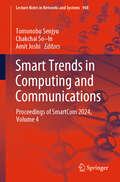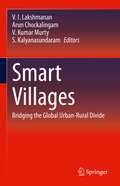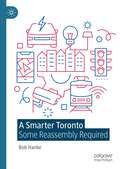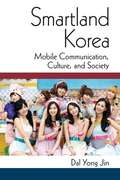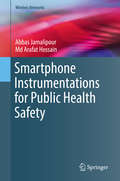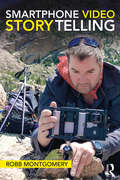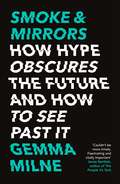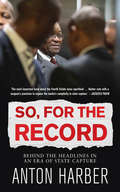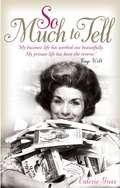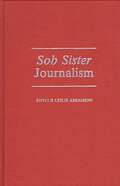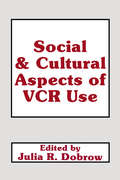- Table View
- List View
Smart Trends in Computing and Communications: Proceedings of SmartCom 2024, Volume 4 (Lecture Notes in Networks and Systems #948)
by Tomonobu Senjyu Chakchai So–In Amit JoshiThis book gathers high-quality papers presented at the Eighth International Conference on Smart Trends in Computing and Communications (SmartCom 2024), organized by Global Knowledge Research Foundation (GR Foundation) from 12 to 13 January 2024 in Pune, India. It covers the state-of-the-art and emerging topics in information, computer communications, and effective strategies for their use in engineering and managerial applications. It also explores and discusses the latest technological advances in, and future directions for, information and knowledge computing and its applications.
Smart Trends in Computing and Communications: Proceedings of SmartCom 2019 (Smart Innovation, Systems and Technologies #165)
by Yu-Dong Zhang Jyotsna Kumar Mandal Chakchai So-In Nileshsingh V. ThakurThis book gathers high-quality papers presented at the International Conference on Smart Trends for Information Technology and Computer Communications (SmartCom 2019), organized by the Global Knowledge Research Foundation (GR Foundation) from 24 to 25 January 2019. It covers the state-of-the-art and emerging topics pertaining to information, computer communications, and effective strategies for their use in engineering and managerial applications. It also explores and discusses the latest technological advances in, and future directions for, information and knowledge computing and its applications.
Smart Trends in Computing and Communications: Proceedings of SmartCom 2020 (Smart Innovation, Systems and Technologies #182)
by Yu-Dong Zhang Tomonoby Senjyu Chakchai So–in Amit JoshiThis book gathers high-quality papers presented at the International Conference on Smart Trends for Information Technology and Computer Communications (SmartCom 2020), organized by the Global Knowledge Research Foundation (GR Foundation) from 23 to 24 January 2020. It covers the state-of-the-art and emerging topics in information, computer communications, and effective strategies for their use in engineering and managerial applications. It also explores and discusses the latest technological advances in, and future directions for, information and knowledge computing and its applications.
Smart Trends in Systems, Security and Sustainability: Proceedings of WS4 2017 (Lecture Notes in Networks and Systems #18)
by Xin-She Yang Atulya K. Nagar Amit JoshiThe volume deals with sustainability transitions which are transformations of major socio-technical systems of provision and use in areas such as energy, water, mobility, and food, towards more sustainable ways of production and consumption. The book provides insights of World Conference on Smart Trends in Systems, Security and Sustainability (WS4 2017) which is divided into different sections such as Smart IT Infrastructure for Sustainable Society; Smart Management prospective for Sustainable Society; Smart Secure Systems for Next Generation Technologies; Smart Trends for Computational Graphics and Image Modelling; and Smart Trends for Biomedical and Health Informatics. The book volume contains 31 high-quality papers presented at WS4 2017.
Smart Villages: Bridging the Global Urban-Rural Divide
by V. I. Lakshmanan Arun Chockalingam V. Kumar Murty S. KalyanasundaramThis book brings together technical expertise, best practices, case studies and ground-level application of the ideas for empowering the rural population of the world to live economically prosperous, environmentally sustainable, and socially progressive lives, on par or comparable with the quality of life enjoyed by the global urban population. The idea of Smart Villages takes on greater urgency in light of the investments made in this millennium on “Smart Cities”, taking advantage of the technological advances, particularly in digital connectivity. These investments have and will continue to expand the urban-rural divide, unless similar investments are made in the villages as well. The book provides a much-needed guide for a holistic development of a Smart Village, by defining the need, developing the framework, and describing the delivery, complete with successful case studies. Contributors to the book, from Canada, USA, Africa and India bring years of academic, industry and governmental experience, including organization of several Smart Village conferences. The knowledge base in the book will be of great value to anyone interested in or active in rural planning, including governmental and non-governmental organizations, industrial solution providers, public healthcare professionals, public policy professionals and students, as well as rural communities around the world. Consolidates all the aspects of creating/developing a Smart Village;Delivers an effective tool-kit for practitioners in the area of Smart Villages;Provides a policy-based framework for the development of an ideal Smart Village;Illustrates, through case studies, the fulfillment of key requirements of a Smart Village;Brings together experts from around the world to share their vision of a Smart Village;Highlights the importance of balancing development with social/gender equity and cultural traditions.
A Smarter Toronto: Some Reassembly Required
by Bob HankeThis book bridges media, technocultural, urban, and journalism studies to examine the role of journalism in relation to a smart city project on Toronto’s waterfront. From the announcement of the public-private partnership called Sidewalk Toronto to the project’s termination, a mediatized controversy unfolded. Through an assemblage approach to this project and a case study of The Globe and Mail and the Toronto Star, it follows the actors and chronicles the Quayside project story as a conversation about the promise and perils of a future “smart” neighbourhood. In the news of Waterfront Toronto, Sidewalk Labs, other actors, events, and developments, there were multiple voices and views, interpretations and arguments, that manifested conflicting interests and values. As a locally situated actor, journalism produced a porous discourse that expressed a proposeand- public pushback movement. This work of articulating mediation conditioned the project’s alteration and dissolution within asymmetrical relations of power. In addition to a wave of opposition that inflected the project’s enactment, a time lag between project time and governmental policymaking made the controversy over this future urban space intractable. With their residual symbolic power, quality journalism contributed to dialogical urban learning.
Smartland Korea: Mobile Communication, Culture, and Society (Perspectives On Contemporary Korea)
by Dal Yong JinThe dramatic advancement of cellphone technology has fundamentally changed our daily lives. Smartphones and their applications have created new capital for information and communication technology corporations and changed the way people communicate. Because of an interesting awareness of the significance for digital economy and people’s daily culture, many countries, from the U.S. to China, have massively invested in the smartphone industries since the early 21st century. Among them, South Korea has become one of the centers for technology development and digital culture, although the country was once lagging behind in the penetration of the phones and their apps. Yet within the last few years, the country has taken a big step toward their goal of becoming a ‘mobile game wonderland’ by appropriating smartphones and it now exists as a curious test-bed for the future of smartphone technology. Smartland Korea, as the first attempt to comprehensively analyze mobile communication in the context of Korean smartphones, looks into a largely neglected focus of inquiry, a localized mobile landscape, with particular reference to young Koreans’ engagement with their devices and applications. Dal Yong Jin focuses not only on the celebratory achievement of technological advancement, but also the significance of social milieu in the development of the smartphones. He situates the emergence of smartphones within the growth of mobile technologies and overall telecommunications industries embedded in Korea’s information and communication technologies. The book examines the technology’s innovation and the evolution, the digital economy through the lens of political economy, and the youth culture embedded in the Korean smartphone context.
Smartphone Instrumentations for Public Health Safety (Wireless Networks)
by Abbas Jamalipour Md Arafat HossainA significant and convenient approach to detection and analysis of biological, environmental and agricultural items is the harnessing of features in widely available smartphones to create field-deployable scientific instruments, allowing measurements to be made onsite and in real-time. This book will cover a number of self-contained smartphone instruments with the particular focus on spectroscopic-based measurements. Measurement and analysis on precision of such low-cost instrumentations are provided to compare with more expensive commercial equipment. This book also discusses some limitations, possible recommendations and scopes for further instrumentations using smartphones and other smart devices. Particularly, the opportunity to integrate the devices into the global Internet-of-Things (IoT) platform will be discussed. Researchers and instrumentation designers in optical and photonic sensing, smart and IoT-based sensing, biological and environmental analysts, agricultural, and food quality researchers (and public health authorities) will find this book useful as reference. Students in science and engineering disciplines for teaching and educational purposes will also find this book useful as a secondary textbook.
Smartphone Video Storytelling
by Robb MontgomerySmartphone Video Storytelling helps readers master the techniques for making compelling short-form video content with a smartphone. With mobile journalism on the rise, it’s becoming increasingly important to understand the entire process and potential for conveying stories across multiple platforms. This richly illustrated text provides students with the essential smartphone video reporting skills: From choosing the right editing app to working with interview subjects on camera. The ethics of non-fiction video storytelling are highlighted to reinforce core journalistic principles. The chapters feature mini-tutorials and exercises that introduce the key principles of filmmaking. The student exercises and library of online video lessons introduce the building blocks of visual storytelling using real-world reporting examples. A story-based approach allows instructors to use the experiences of making each project in order to teach the fundamentals of video storytelling in a natural way. Each story lesson introduces the necessary stages, including planning, filming, and editing . . . and all with a smartphone. Online example videos can be found at http://smartfilmbook.com/
Smartphone Video Storytelling
by Robb MontgomerySmartphone Video Storytelling helps readers master the techniques for making compelling short-form video content with a smartphone. With mobile journalism on the rise, it’s becoming increasingly important to understand the entire process and potential for conveying stories across multiple platforms. This richly illustrated text provides students with the essential smartphone video reporting skills: From choosing the right editing app to working with interview subjects on camera. The ethics of non-fiction video storytelling are highlighted to reinforce core journalistic principles. The chapters feature mini-tutorials and exercises that introduce the key principles of filmmaking. The student exercises and library of online video lessons introduce the building blocks of visual storytelling using real-world reporting examples. A story-based approach allows instructors to use the experiences of making each project in order to teach the fundamentals of video storytelling in a natural way. Each story lesson introduces the necessary stages, including planning, filming, and editing . . . and all with a smartphone. Online example videos can be found at http://smartfilmbook.com/
Smartphones, Current Events and Mobile Information Behavior: Consuming, Reacting, Sharing, and Connecting through News
by Kyong Eun Oh Rong TangSmartphones and Information on Current Events provides unprecedented insights into young people’s news consumption patterns and the ecology of mobile news. Advancing our knowledge of mobile behaviour, the book also highlights the ways in which mobile news impacts the lives of the general public. Using a multi-faceted research model on mobile news consumption behaviour, Oh and Tang examined a wide spectrum of mobile news consumption activities, outlined the key characteristics of mobile news, as well as captured users’ near real-time evaluation of and emotional reactions to news stories. The book also shows that the process of using smartphones to receive, read, find, share, and store news stories has resulted in new behavioural patterns that enable people to consume news in a multifaceted way. Analyzing the extent and various methods of mobile news sharing can, Oh and Tang argue, help us understand how such exchanges reshape contemporary society. Demonstrating that mobile news consumption is now an integral part of people’s daily lives, the book clearly shows that its impact on people’s day-to-day activities, and their political and social lives, cannot be underestimated. Smartphones and Information on Current Events will be useful to scholars, students, and practitioners who are studying library and information science, journalism and media, digital communication, user behaviour, information technology, human-computer interaction, marketing, political science, psychology, and sociology.
Smartphones, Current Events and Mobile Information Behavior: Consuming, Reacting, Sharing, and Connecting through News
by Kyong Eun Oh Rong TangSmartphones and Information on Current Events provides unprecedented insights into young people’s news consumption patterns and the ecology of mobile news. Advancing our knowledge of mobile behaviour, the book also highlights the ways in which mobile news impacts the lives of the general public. Using a multi-faceted research model on mobile news consumption behaviour, Oh and Tang examined a wide spectrum of mobile news consumption activities, outlined the key characteristics of mobile news, as well as captured users’ near real-time evaluation of and emotional reactions to news stories. The book also shows that the process of using smartphones to receive, read, find, share, and store news stories has resulted in new behavioural patterns that enable people to consume news in a multifaceted way. Analyzing the extent and various methods of mobile news sharing can, Oh and Tang argue, help us understand how such exchanges reshape contemporary society. Demonstrating that mobile news consumption is now an integral part of people’s daily lives, the book clearly shows that its impact on people’s day-to-day activities, and their political and social lives, cannot be underestimated. Smartphones and Information on Current Events will be useful to scholars, students, and practitioners who are studying library and information science, journalism and media, digital communication, user behaviour, information technology, human-computer interaction, marketing, political science, psychology, and sociology.
SMEs as the Unknown Stakeholder: Entrepreneurship in the Political Arena
by Massimiliano Di Bitetto GianMarco GilardoniInvestigates how and to what extent the self-employed and micro-enterprise workers can be represented in the social arena. A cross-sector approach to responsibility for government as well as private businesses.
Smoke & Mirrors: How Hype Obscures the Future and How to See Past It
by Gemma Milne'Stop following the news until you've read Gemma Milne's persuasive analysis of the hype and bullshit that distort our understanding of emerging science. As she shows, the starting point to grasping the genuine opportunities of AI, life sciences and climate tech is a healthy dose of critical thinking'David Rowan, founding editor of WIRED UK and author of Non-Bullshit Innovation: Radical Ideas from the World's Smartest Minds'Couldn't be more timely. Fascinating and vitally important' Jamie Bartlett, author of The People Vs Tech 'A much-needed blast of fresh air! Gemma Milne expertly shows us how to separate the truth from the hype surrounding the emerging techs of today, and those of the near-tomorrow.' Lewis Dartnell, author of Origins: How the Earth Made Us'I loved this book! This is exactly the sort of sceptical, cut-through-the crap-but-still-excited-about-what's-emerging book around tech innovation that's sorely needed, yet is so hard to find . . . essential reading for anyone who's serious about how real-world advances might be effectively harnessed to build a better future.' Dr Andrew Maynard, scientist and author of Films from the Future and Future Rising'Smoke & Mirrors is a vital contribution in a world where technological progress promises so much, but too often disappoints. If, like me, you believe that advances in science and technology are our best hope for solving the grand challenges of our times, this book is the indispensable guide to avoiding the mirages and the charlatans along the way.' Matt Clifford, co-founder and CEO of Entrepreneur First'A refreshingly grown-up, clear-headed look at the interaction between science, technology and the media - readable without being dumbed down, acknowledging complexities without being heavy.' Tom Chivers, author of The AI Does Not Hate You'In this book, we see technological hype for what it is: not mere exuberance, but a form of attention-seeking. As some technological hucksters stake claims on our future and try to foreclose alternatives, we need strong defences. Gemma Milne offers a spotter's guide to hype, using science to bring speculation down to earth. People inside and outside the world of technological innovation need this book.' Jack Stilgoe, author of Who's Driving Innovation?'ROBOTS WILL STEAL YOUR JOB!''AI WILL REVOLUTIONISE FARMING!''GENETIC EDITING WILL CURE CANCER!'Bombastic headlines about science and technology are nothing new. To cut through the constant stream of information and misinformation on social media, or grab the attention of investors, or convince governments to take notice, strident headlines or bold claims seem necessary to give complex, nuanced information some wow factor.But hype has a dark side, too.It can mislead. It can distract. It can blinker us from seeing what is actually going on.From AI, quantum computing and brain implants, to cancer drugs, future foods and fusion energy, science and technology journalist Gemma Milne reveals hype to be responsible for fundamentally misdirecting or even derailing crucial progress.Hype can be combated and discounted, though, if you're able to see exactly where, how and why it is being deployed.This book is your guide to doing just that.
The Snakehead: An Epic Tale of the Chinatown Underworld and the American Dream
by Patrick Radden Keefe‘Reads like a mashup of The Godfather and Chinatown, complete with gun battles, a ruthless kingpin and a mountain of cash. Except that it’s all true.’ TimeIn this thrilling panorama of real-life events, the bestselling author of Empire of Pain investigates a secret world run by a surprising criminal: a charismatic middle-aged grandmother, who from a tiny noodle shop in New York’s Chinatown, managed a multimillion-dollar business smuggling people.In The Snakehead, Patrick Radden Keefe reveals the inner workings of Cheng Chui Ping aka Sister Ping’s complex empire and recounts the decade-long FBI investigation that eventually brought her down. He follows an often incompetent and sometimes corrupt INS as it pursues desperate immigrants risking everything to come to America, and along the way he paints a stunning portrait of a generation of undocumented immigrants and the intricate underground economy that sustains and exploits them.Grand in scope yet propulsive in narrative force, The Snakehead is both a kaleidoscopic crime story and a brilliant exploration of the ironies of immigration in America.
Snapshot: A Reporter's Life
by John ChadwickThey're shelling our rear lines,' said the Pakistani officer 'Not to worry. It's over our heads There you have it. The entire subcontinent in a nutshell. From his leisurely retirement in the heart of rural England, former Reuters journalist John Chadwick reflects on the hurly-burly of forty years of news chasing that took him from the Upper Nile to the Arctic Circle and from Pakistan to the Pacific Coast of America. John Chadwick's first Reuters job was the Cod War. He reported from JFK's America and the United Nations, covered Indo-Pakistan and Middle East conflicts and reported from European capitals before, during and after the Wall. He's found time to train new generations and indulge his love of literature and music from Mozart to Jelly-Roll Morton. I have walked through these streets at night, when all is silent and only the moonlight casts shadows over the clean and deserted pavements. The architecture retakes centre stage, and the classic French style of the building designs once again becomes apparent. As you walk, your eyes are drawn to the beautiful carved doorways and ornate shutters. Above, the ghostly modern additions to the already complicated rooftops mingle with the silhouettes of mature trees and vibrant bougainvillaea that have taken on the black hues of midnight. It could all be a pen and ink sketch for, here in the heart of the city by moonlight, the streets take on a beauty they do not possess in the afternoon sun. Gael Harrison's life has almost come full circle, from her birth and schooling as a British rubber planter's daughter in Kuala Lumpur, Malaysia, to her newly found life in Vietnam. In 2001 Volunteer Services Overseas assigned Gael to a Save the Children Fund project in the remote Vietnamese highlands where only ethnic dialects were spoken. The daunting task of existing and working in these areas, in spite of speaking neither Vietnamese nor the local dialects, reveals the qualities that allow Gael to tell her story of the seldom-seen world of the volunteer in a difficult and alien environment through very human eyes. Gael is now remarried and continues to live and work in Hanoi.
So, for the record: Behind the Headlines in an Era of State Capture
by Anton Harber‘Only Anton Harber, a pioneer of independent journalism in south Africa and one of the keenest observers of the media around, could have written the thriller that is this book.’ – Jacob DlaminiVeteran journalist Anton Harber brings all his investigative skills to bear on his very own profession, the media. For two years he conducted dozens of interviews with politicians, journalists, policemen, state security agents and ‘deep throats’, before piecing together two remarkable tales.The first is a chilling story of police death squads, rogue units and renditions, and how South Africa’s biggest newspaper was duped into doing the dirty work of corrupt politicians. The second starts with a broken and discarded hard drive and evolves, with many near misses, into the exposure of the depths of the Guptas’ influence over the ruling party.Harber’s two tales reveal the lows and highs of journalism during an era of state capture. His book is both a disquieting exposé of how easily the media can be duped by a conniving cabal for its own selfish ends, and a celebration of brilliant investigative reporting by brave and ethical journalists.
So Much To Tell
by Valerie GroveKaye Webb, a journalist with no publishing experience, burst into the world of children's books in 1961 and changed the face of children's publishing forever. Her child-like enthusiasm and shrewd business mind led her to become Puffin's most successful editor and the genius behind the Puffin Club, which opened up the exciting world of authors and books to children across Britain. But whilst Kaye's professional life had worked out beautifully, her private life had been the reverse. Kaye had two husbands before her marriage to the artist Ronald Searle, and the torment of his sudden and shocking departure never left her.Yet to the outside world Kaye Webb remained passionate and unstoppable. This is the unknown story of the woman who brought the joy of books to children everywhere whilst battling the emotional pain that plagued her private life.
So You Want to be a Political Journalist
by Sheila GunnIn the wake of 2010's historic general election politics commands more column inches and air time than ever before. Yet most political journalists failed to foresee the consequences of a coalition government. And they are still struggling to understand and reflect the new political environment in their coverage. While there is plenty of debate about the current state of politics and journalism, aspiring political reporters receive little guidance. Are unscrupulous spin doctors simply spoon-feeding them stories? Do they push their own politically-biased agendas? This book aims to focus on helping to produce competent and confident journalists who report on politics without fear or favour. With chapters on starting out in the trade, where to find the story, how to report it, and how to deal with the political classes, this book is the essential guide for journalism students, trainee journalists and journalists looking to understand the mechanisms of Westminster and Whitehall. Edited by Sheila Gunn, who was a political reporter on The Times and spin doctor to John Major, So You Want To Be A Political Journalist features contributions from a wide range of current and former political journalists from print, broadcast and on-line media.An essential resource for journalism students and the perfect refresher for seasoned reporters.Author lectures on political journalism on City University's prestigious journalism course.The National Council for the Training of Journalists (NCTJ) recognizes 63 journalism courses at colleges around Britain. In addition, there are hundreds of further colleges and organisations running media studies courses.
Sob Sister Journalism (Contributions to the Study of Mass Media and Communications)
by Phyllis AbramsonOn June 25, 1906 an event of little public importance occurred. Fueled by popular mood and climate, and capitalized upon by the press, it became the hottest story of the century. Phyllis Leslie Abramson's book recreates the social, political, and economic climate; the murder; and the subsequent trial that led to the manifestation of sob sister journalism. The story was prosaic: an insanely jealous man murdered his wife's lover. The protagonists were front-page material: Stanford White, famous architect and womanizer; Harry K. Thaw, scion of an influential family; and the young and beautiful Evelyn Nesbit. Three famous newspapers chose four women journalists to provide daily doses of tear-producing reportage. The sob sisters were born.Exploring the origins of sob sister journalism, Abramson first surveys turn-of-the-century America. She includes sections on industrialization, urbanization, immigration, the political climate, women, the press, and New York City, and gives biographical sketches of the four female journalists. The trial itself encompasses the main portion of her book. Day-by-day courtroom events alternate with the sob sisters' actual newspaper coverage. The volume concludes with an analysis of the development of sob sister journalism and the impact of this new journalistic style. An appendix offers a postscript on the lives of the protagonists and the sob sisters.
Social and Behavioral Research for Homeland Security
by John G. VoellerSocial and Behavioral Research for Homeland Security features articles from the Wiley Handbook of Science and Technology for Homeland Security covering social and psychological aspects of terrorism and counterterrorism efforts from different perspectives. First, it examines the roots of terrorism; second, it explores the consequences of terrorism; then communication, training, and learning development of responders and the public in situations of terror attacks, are discussed.
Social and Behavioral Research for Homeland Security
by John G. VoellerSocial and Behavioral Research for Homeland Security features articles from the Wiley Handbook of Science and Technology for Homeland Security covering social and psychological aspects of terrorism and counterterrorism efforts from different perspectives. First, it examines the roots of terrorism; second, it explores the consequences of terrorism; then communication, training, and learning development of responders and the public in situations of terror attacks, are discussed.
Social and Cognitive Approaches to Interpersonal Communication
by Susan R. Fussell Roger J. KreuzHistorically, the social aspects of language use have been considered the domain of social psychology, while the underlying psycholinguistic mechanisms have been the purview of cognitive psychology. Recently, it has become increasingly clear that these two dimensions are highly interrelated: cognitive mechanisms underlying speech production and comprehension interact with social psychological factors, such as beliefs about one's interlocutors and politeness norms, and with the dynamics of the conversation itself, to produce shared meaning. This realization has led to an exciting body of research integrating the social and cognitive dimensions which has greatly increased our understanding of human language use. Each chapter in this volume demonstrates how the theoretical approaches and research methods of social and cognitive psychology can be successfully interwoven to provide insight into one or more fundamental questions about the process of interpersonal communication. The topics under investigation include the nature and role of speaker intentions in the communicative process, the production and comprehension of indirect speech and figurative language, perspective-taking and conversational collaboration, and the relationships between language, cognition, culture, and social interaction. The book will be of interest to all those who study interpersonal language use: social and cognitive psychologists, theoretical and applied linguists, and communication researchers.
Social and Cognitive Approaches to Interpersonal Communication
by Susan R. Fussell Roger J. KreuzHistorically, the social aspects of language use have been considered the domain of social psychology, while the underlying psycholinguistic mechanisms have been the purview of cognitive psychology. Recently, it has become increasingly clear that these two dimensions are highly interrelated: cognitive mechanisms underlying speech production and comprehension interact with social psychological factors, such as beliefs about one's interlocutors and politeness norms, and with the dynamics of the conversation itself, to produce shared meaning. This realization has led to an exciting body of research integrating the social and cognitive dimensions which has greatly increased our understanding of human language use. Each chapter in this volume demonstrates how the theoretical approaches and research methods of social and cognitive psychology can be successfully interwoven to provide insight into one or more fundamental questions about the process of interpersonal communication. The topics under investigation include the nature and role of speaker intentions in the communicative process, the production and comprehension of indirect speech and figurative language, perspective-taking and conversational collaboration, and the relationships between language, cognition, culture, and social interaction. The book will be of interest to all those who study interpersonal language use: social and cognitive psychologists, theoretical and applied linguists, and communication researchers.
Social and Cultural Aspects of Vcr Use (Routledge Communication Series)
by Julie DobrowFirst Published in 1990. Routledge is an imprint of Taylor & Francis, an informa company.
